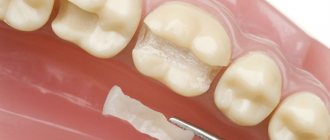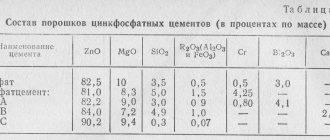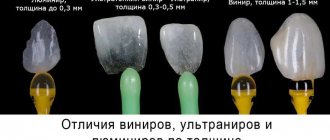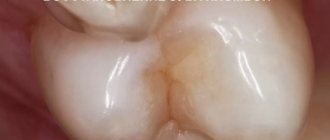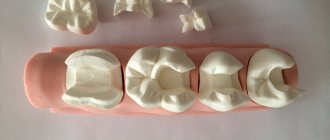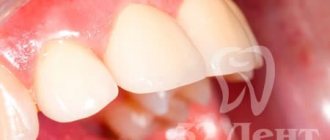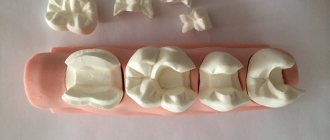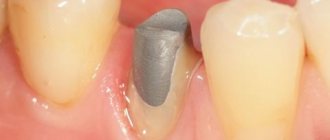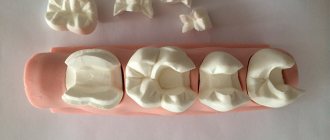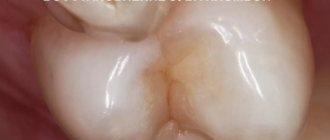- Types of products
- Ceramic inlay e max: main indications
- Contraindications for installing ceramic inlays
- Ceramic tooth inlay: advantages and disadvantages of products
- Manufacturing and installation stages
- Ceramic dental inlay: care features
If it is necessary to carry out extensive restoration, they often resort not to filling material, but to ceramic inlays (onlays).
They are one of the best methods of dental restoration and provide high-quality results. Ceramic inlays are a microprosthesis that is fixed in the tooth cavity. Such orthopedic structures are characterized by high aesthetics and durability; they are completely identical to healthy enamel, due to which they have become widespread. The e max ceramic inlay is in particular demand; it can be installed in a reliable dental clinic “A-medic”. The company's pricing policy is loyal, the cost of the service starts from 15,000 rubles. Before installing a microprosthesis, dentists conduct an examination and diagnosis to identify possible contraindications. In dentistry, a ceramic inlay is installed in just 2 stages, which allows you to quickly make your smile more attractive. An individual approach to each patient is guaranteed.
How does an inlay differ from a filling?
The filling is made of a plastic material that hardens and takes the desired shape. It is made and installed right in the dentist's office in one appointment. However, a filling will not help when the tooth is severely damaged. In this case, you will need a ceramic inlay. It is made in the laboratory using an individual impression. It not only closes the resulting cavity, but also exactly repeats the shape of the destroyed area of the crown.
Advantages over fillings:
- Higher efficiency
. It is possible to restore a severely damaged tooth. A filling is suitable only if the cavity occupies less than a quarter of the crown, and an inlay can restore from 25 to 60%; - Naturalness
. The inlay imitates the anatomical shape of the chewing surface. It is almost invisible, while the filling can be seen; - Higher strength
. Microprostheses do not develop cracks. A filling of this size would quickly crumble, so it is not suitable for restoring extensive damage; - Durability
. The tab will last 5–7 years. At the same time, it will remain unchanged and will not lose its original characteristics; - Ensuring the prevention of secondary caries
. Sometimes the filling can become infected again. The insert fits very tightly and does not shrink over time, so this risk is eliminated; - Color fastness
. The fillings have a porous structure, so they are easily stained by tea, coffee, and tobacco. Ceramics are not subject to color changes.
Flaws:
- They cost more;
- They take longer to produce. The filling can be placed in one visit to the dentist. And to install the tab, you will need 2 visits with a break for the manufacture of a microprosthesis in the laboratory.
What is made from e-max ceramics?
The latest generation of metal-free ceramics e-max is used in various areas of dentistry. Thanks to its unique properties, it displaces many other materials, especially since Ivoclar Vivadent is constantly improving its products and developing new technologies. e-max technology is used to create the following dental structures:
- Veneers e-max. These are thin plates designed to correct external dental defects and improve your smile. Such designs are durable, highly aesthetic and do not cause an allergic reaction. Over the years, they retain their original appearance and do not darken or turn yellow.
- All-ceramic crowns. They are no different from living teeth and match the shade of natural enamel. This type of prosthesis is indicated for those patients who are allergic to metal. With proper care, crowns made using e-max technology will last a lifetime.
- Ceramic inlays. They are much stronger than conventional composite fillings, are made individually for each patient, are securely fixed in the oral cavity and perfectly imitate natural dentin. Most often, e-max technology is used in the A-medic clinic specifically to create inlays, so we will tell you in more detail about these microprostheses.
Indications
The main use case is the treatment of caries. A ceramic inlay for a tooth is needed if its crown is destroyed by 25–60%. If the cavity occupies less than a quarter of the surface, then you can get by with a filling, but if more than 60%, then a crown is needed. Other indications for installation:
- Destruction of non-carious origin;
- The need to install a bridge prosthesis (microprostheses are placed on abutment teeth to increase their strength);
- Increased abrasion of enamel.
Reviews
Despite the high cost, ceramic inlays are very popular among patients in dental clinics, judging by the reviews.
This is due to their high quality, aesthetic characteristics and service life.
You can share your opinion about the use of ceramic microprostheses in the comments section.
If you find an error, please select a piece of text and press Ctrl+Enter.
Tags inlay ceramic inlay fixed dentures
Did you like the article? stay tuned
Previous article
Purpose of using turunda after tooth extraction
Next article
All the details of laser teeth removal
Contraindications
This type of microprosthesis cannot be installed in the following cases:
- bruxism (grinding teeth in sleep);
- steep slopes of hillocks;
- rapidly progressing caries;
- deep cavity extending into dentin;
- inability to ensure complete dryness of the field.
A relative contraindication is poor oral hygiene. In what cases is it not advisable to use:
- A cavity less than 1.5 mm deep (you can get by with a filling);
- The damage has affected the cervical area of the tooth (the inlay will no longer help);
- The tooth is more than 60% destroyed (a crown is required);
- Milk tooth. It makes no sense to restore it using an inlay, since the life of the tooth is less than the durability of the microprosthesis. In addition, a vlkadka costs much more than a filling. Spending so much money to restore a tooth that will soon fall out is not advisable.
More examples
Example 1:
Here the tooth is cracked due to a large filling.
Example 2: filling with usual indications
Given:
Correct fillings:
Types of tabs
Depending on the material of manufacture, they come in the following types:
- metal-ceramic
- the most budget-friendly; - ceramic
– the most aesthetic; - made of zirconium dioxide
- the most durable.
These microprostheses are also classified depending on their position in the tooth. According to this criterion, the following varieties are distinguished:
- Inlay
– the hole in the tooth is box-shaped, the inlay is installed inside it; - Onlay
– the overlay has an external side; - Overlay
– only one wall is preserved, the overlay replaces almost the entire crown; - Pinlay
– the inlay has additional cavities or pin inclusions for better fixation.
The type of inlay based on its position in the tooth is selected by the dentist after an initial consultation.
The process of manufacturing and installing inlays on a tooth
Dental prosthetics is performed in several stages:
- Initial consultation
. The doctor assesses the extent of destruction and draws up a recovery plan; - Hygienic teeth cleaning
if necessary; - Selection of the required shade
to match the enamel color; - Removal of tissues affected by caries
, if the destruction was caused by this disease; - Taking an individual impression
, according to which a microprosthesis will be made; - Closing the cavity with temporary material
for the waiting period; - Making an inlay
based on an individual impression in a dental laboratory; - Installation
of the inlay and its fixation using special dental cement.
Thus, a tooth can be restored in 2 visits to the clinic. The first visit is a consultation, treatment of caries and taking an impression, the second is the actual installation.
Possible complications
Fixation of the microprosthesis is accompanied by grinding down the surface of the tooth in order to remove tissue affected by caries.
With a highly professional dentist, this procedure does not cause problems, however, in some cases it can lead to the development of secondary caries - if the affected tissue or pulpitis is not carefully removed.
The increased sensitivity of the patient's teeth can lead to the fact that after installing a microprosthesis, at first there will be discomfort and a feeling of the presence of a foreign object in the oral cavity. Over time, this feeling will disappear.
In some cases, the patient may experience an opening of a cavity in the body of the tooth , which entails the loss of the inlay.
In this situation, you should immediately contact your dentist to re-fix the product or make a new microprosthesis.
Pros of ceramic inlays
A ceramic tooth inlay has many advantages:
- High strength
. An inlay, unlike a filling, significantly strengthens the tooth. Therefore, it is the preferred option if the tooth in which it is installed will be used as a support for a bridge; - Good aesthetic properties
. Ceramics are translucent, so they successfully imitate the natural color of the tooth. It also exactly follows the normal shape of his crown; - The ability to fully restore the chewing surface
. The inlay completely follows the anatomical shape of the tooth. This provides convenience when eating; - Hygiene
. Glaze is applied to the tab as a finishing layer. It creates a glossy surface on which plaque does not accumulate; - Resistance to external factors
. Ceramics does not darken over time, does not change color due to smoking or drinking coloring drinks; - Durability
. A ceramic inlay will last longer than a filling – 5–7 years. There are also more durable inlays, for example, made of zirconium dioxide, but ceramic ones are more aesthetically pleasing compared to them; - No risk of secondary caries
. Inlays, unlike fillings, do not shrink and adhere tightly to the tissue. This eliminates the possibility of cracks and the development of secondary carious lesions; - Easy replacement
. When installing a new inlay after its service life has expired, there is no need to grind the tooth again. Caries does not develop under a microprosthesis of this type, so there is no need to remove the affected tissue. - Bioinertness
. Ceramics does not absorb or accumulate any odors. There is no plaque deposited on it; - Hypoallergenic
. Microprostheses made of pure ceramics do not cause any immune reactions; - No need for special care
. Regular hygiene rules are sufficient.
Why should you contact TriDental dentistry?
The most painful process during prosthetics is the grinding of bone tissue; the patient feels discomfort, but not pain, since the process is carried out under local anesthesia. First, the dentist cleans the oral cavity and removes plaque and tartar, after which an x-ray is taken, impressions are taken, and an antiseptic treatment is performed.
Many years of experience and equipping the clinic with modern European equipment allowed us to select the most effective and painless treatment methods. Our advantages:
- low prices for ceramic tooth inlays;
- use of high-quality anesthesia;
- individual approach to each patient;
- All services are guaranteed!
To clarify details or make an appointment for the installation of ceramic crowns and inlays, you can always contact our employees for help by phone or through the feedback form on the official website.
